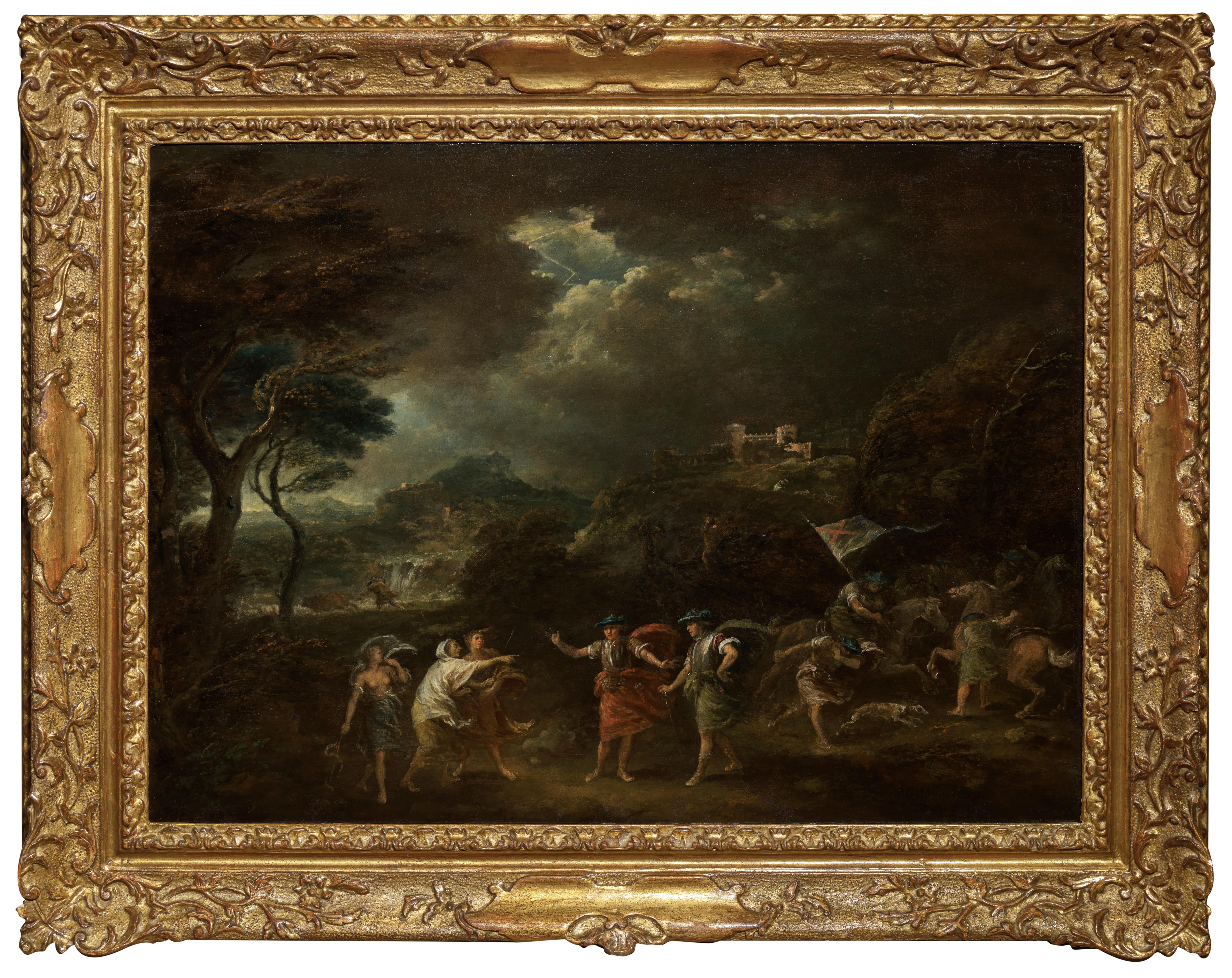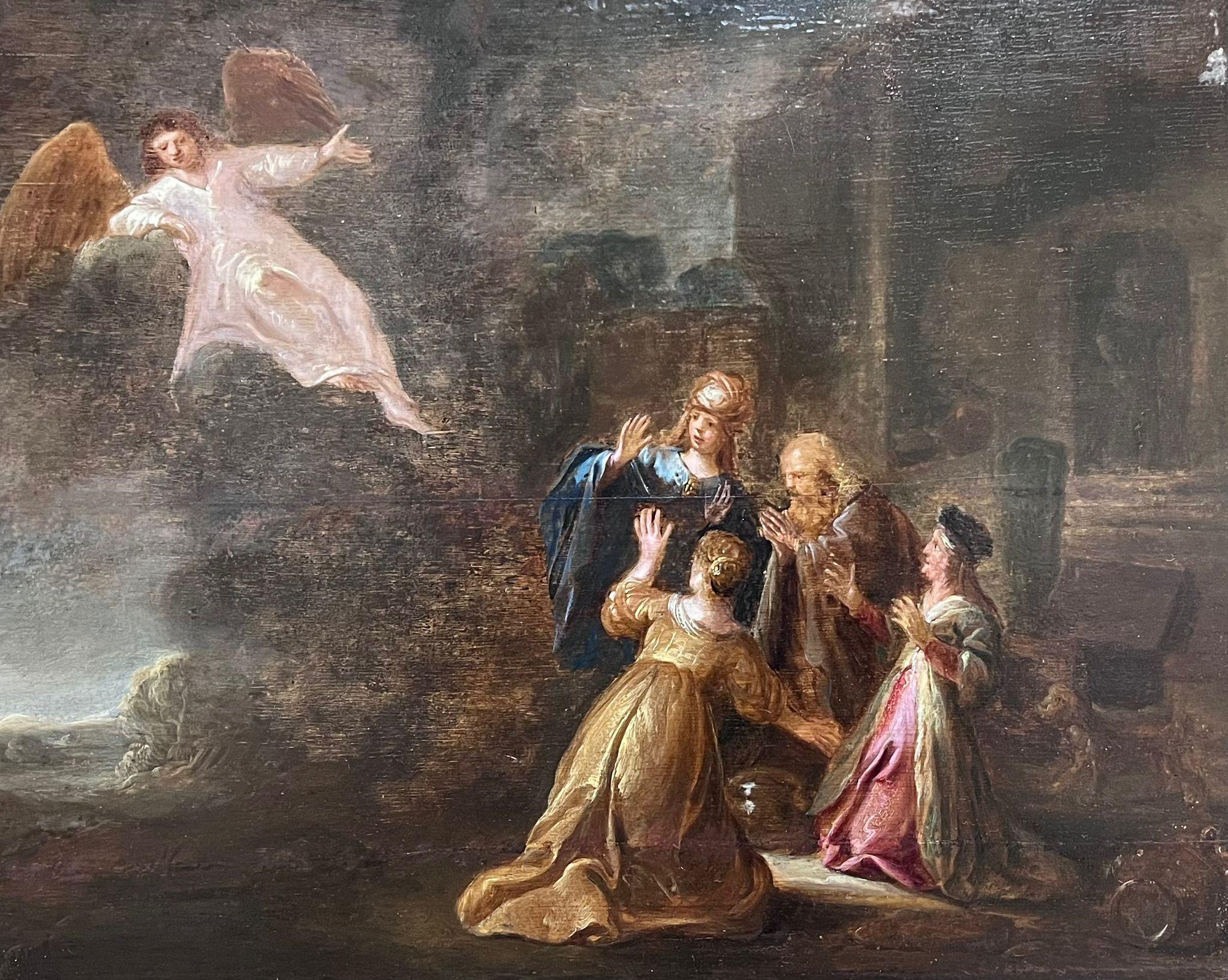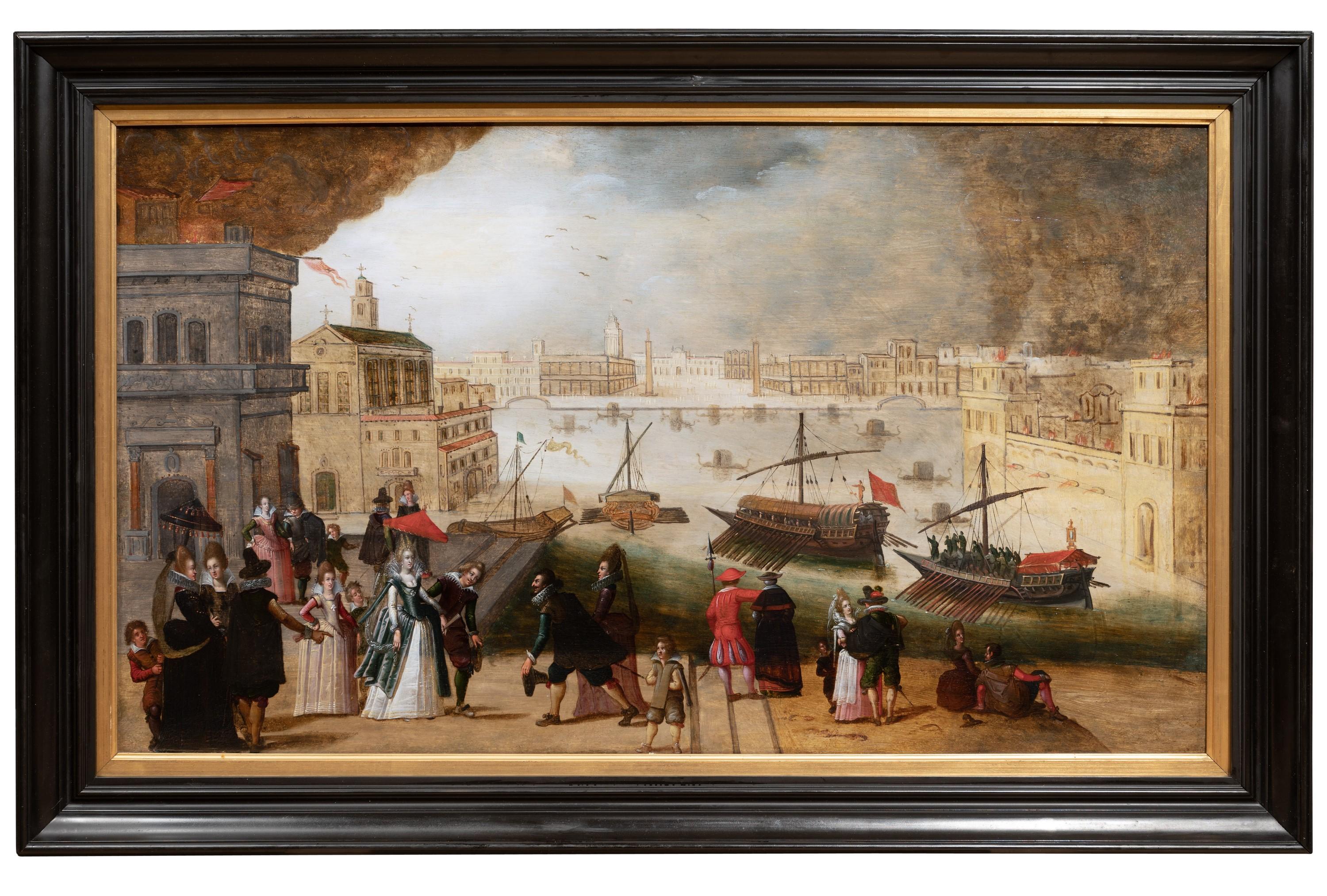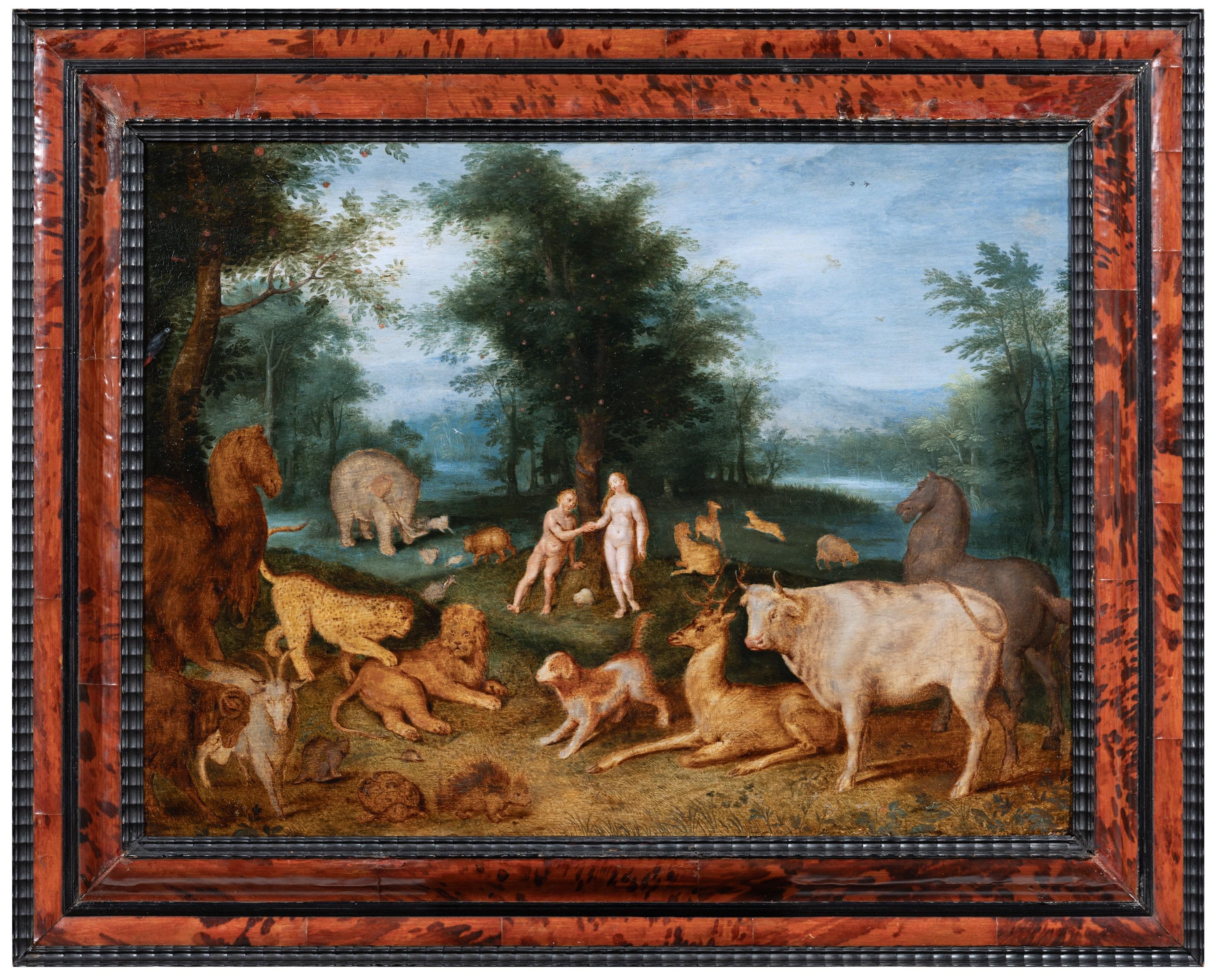Items Similar to Italian Landscape With Figures at a Waterfall by a Follower of Jan van Huysum
Want more images or videos?
Request additional images or videos from the seller
1 of 6
Italian Landscape With Figures at a Waterfall by a Follower of Jan van Huysum1700s
1700s
About the Item
There are so many details to fall in love with in this 18th-century painting depicting an Italianate landscape, for example, the delicately painted figures having a conversation and the waterfall in the centre of the composition, and the small birds flying in the sky. And not least, how the shadows are beautifully painted with a confident hand.
The artist is yet unknown; it reminds of the landscapes by Jan van Huysum (Compare with inventory nr 72 at Mauritshaus, Italian landscape by Jan van Huysum)
oil on panel
panel dimensions 9.64 x 13.97 inches (24.5 x 35.5 cm)
frame 13.77 x 17.71 inches (35 x 45 cm)
- Creation Year:1700s
- Dimensions:Height: 9.65 in (24.5 cm)Width: 13.98 in (35.5 cm)
- Medium:
- Movement & Style:
- After:Jan Van Huysum (1682 - 1749, Dutch)
- Period:
- Condition:
- Gallery Location:Stockholm, SE
- Reference Number:1stDibs: LU1445210559752
About the Seller
5.0
Platinum Seller
These expertly vetted sellers are 1stDibs' most experienced sellers and are rated highest by our customers.
Established in 2020
1stDibs seller since 2020
118 sales on 1stDibs
Typical response time: <1 hour
Associations
International Confederation of Art and Antique Dealers' Associations
- ShippingRetrieving quote...Ships From: Stockholm, Sweden
- Return PolicyA return for this item may be initiated within 2 days of delivery.
More From This SellerView All
- Dutch School, 17th Century, Shipping in a Stiff Breeze, a City BeyondLocated in Stockholm, SEWe are delighted to present a significant piece from the Dutch School, most likely dating back to the late 17th century. This captivating painting showcases the dynamic force of nature with three ships vigorously navigating through stormy waters. The foreground is a scene of nautical struggle, as figures are depicted working intensely with the sails, steering, and bracing against the tumultuous sea. In the serene background, the silhouette of a quaint town emerges, with spires from churches and the outlines of various buildings is visible. This juxtaposition of the calm town against the chaotic foreground serves as a powerful reminder of the unpredictability of life and nature. Dominating the canvas, the sky occupies two-thirds of the painting, filled with brooding clouds that occasionally break to reveal patches of blue. The presence of birds adds a dynamic element to the otherwise ominous atmosphere. While the artist remains unknown, the work is quintessentially Dutch in its execution, with meticulous attention to detail and a profound understanding of maritime life. The painting's oval shape is quite distinctive and is complemented by a suitably antique octagonal black frame, which adds to its historical charm. This piece is a testament to the mastery of Dutch maritime painting...Category
17th Century Old Masters Landscape Paintings
MaterialsOak, Oil, Wood Panel
- Landscape with Gentleman on Horseback and Peasant Woman Receiving AlmsBy Philips WouwermanLocated in Stockholm, SEWorkshop / Circle of Philips Wouwerman (1619-1668) Landscape with Gentleman on Horseback and Peasant Woman Receiving Alms oil on oak panel 12.40 x 14.17 inches (31.5 x 36 cm) wit...Category
17th Century Old Masters Landscape Paintings
MaterialsOak, Oil, Wood Panel
- A Peasant Removing a Plaster: The Sense of Touch. By a Follower of David TeniersBy David Teniers the YoungerLocated in Stockholm, SEDavid Teniers the Younger (1610-1690) Follower of A Peasant Removing a Plaster: The Sense of Touch signed T on the table oil on panel panel size 7,20 x 5,55 inches (18,3 x 14,4 cm)...Category
Early 18th Century Old Masters Figurative Paintings
MaterialsPanel, Oil
- Old Master Painting, Flemish School from 1600s, Saint Nicholas of TolentinoLocated in Stockholm, SEThis small Flemish painting, measuring only 24.5 x 18.5 cm and executed on a copper plate, depicts Saint Nicholas of Tolentino. Created in the 17th century, the artist remains unknow...Category
17th Century Old Masters Landscape Paintings
MaterialsCopper
- Shipping in Stormy Waters, Attributed to Italian Artist Francesco GuardiBy Francesco GuardiLocated in Stockholm, SEThe splendour of the tragic sea Francesco Guardi and maritime painting in Venetian art No Venetian painter was a stranger to the sea. After all, Venice was not only one of the most prominent ports of the Mediterranean, but indeed a city literally submerged in the ocean from time to time. Curiously however, the famous Venetian school of painting showed little interest in maritime motifs, favouring scenes from the iconic architecture of the city rather than seascapes. That is why this painting is a particularly interesting window into not only the painter Francesco Guardi himself – but to the significance of the element of water in art history, in absence as well as in the centre of attention. Whether it be calm, sunny days with stunning views of the palaces alongside the canals of Venice or – more rarely – stormy shipwrecking tragedies at sea, water as a unifying element is integral to the works of painter Francesco Guardi (1712–1793). During his lifetime, Venetian art saw many of its greatest triumphs with names like Tiepolo or Canaletto gaining international recognition and firmly establishing Venice as one of the most vibrant artistic communities of Europe. While the city itself already in the 18th century was something of an early tourist spot where aristocrats and high society visited on their grand tour or travels, the artists too contributed to the fame and their work spread the image of Venice as the city of romance and leisure to an international audience, many of whom could never visit in person. Still today, the iconic image of Venice with its whimsical array of palaces, churches and other historic buildings is much influenced by these artists, many of whom have stood the test of time like very well and remain some of the most beloved in all of art history. It was not primarily subtility, intellectual meanings or moral ideals that the Venetian art tried to capture; instead it was the sheer vibrancy of life and the fast-paced city with crumbling palaces and festive people that made this atmosphere so special. Of course, Venice could count painters in most genres among its residents, from portraiture to religious motifs, history painting and much else. Still, it is the Vedutas and views of the city that seems to have etched itself into our memory more than anything else, not least in the tradition of Canaletto who was perhaps the undisputed master of all Venetian painters. Born into his profession, Francesco lived and breathed painting all his life. His father, the painter Domenico Guardi (1678–1716) died when Francesco was just a small child, yet both he and his brothers Niccolò and Gian Antonio continued in their fathers’ footsteps. The Guardi family belonged to the nobility and originated from the mountainous area of Trentino, not far from the Alps. The brothers worked together on more challenging commissions and supported each other in the manner typical of family workshops or networks of artists. Their sister Maria Cecilia married no other than the artist Giovanni Battista Tiepolo himself, linking the family to the most renowned Venetian name of the time. During almost a decade, Guardi worked in the studio of Michele Giovanni Marieschi, sometimes simply known as Michiel, a painted similar in both style and motif. Canaletto is, however, the artist Guardi is most often compared to since they shared a mutual fascination for depicting the architecture and cityscape of Venice. During the course of his career, Guardi tried his hand in many different genres. He was as swift in painting landscapes, Vedutas of Venice, sacred motifs, interiors and architectural compositions as he was in a number of other motifs. His style is typical of the Venetian school but also distinct and personal once we look a little closer. There is an absolute certainty in the composition, the choice of which sometimes feels like that of a carefully calculated photograph – yet it is also very painterly, in the best sense of the word: fluid, bold, sensitive and full of character. The brushwork is rapid, intense, seemingly careless and extraordinarily minute at the same time; fresh and planned in a very enjoyable mixture. His interiors often capture the breath-taking spacious glamour of the palaces and all their exquisite decor. He usually constructed the motif through remarkably simple, almost spontaneous yet intuitively precise strokes and shapes. The result was a festive, high-spirited atmospheric quality, far away from the sterile and exact likeness that other painters fell victim to when trying to copy Canaletto. The painting here has nothing of the city of Venice in it. On the contrary, we seem to be transported far away into the solitary ocean, with no architecture, nothing to hold on to – only the roaring sea and the dangerous cliffs upon which the ships are just moments away from being crushed upon. It is a maritime composition evoking both Flemish and Italian precursors, in the proud tradition of maritime painting that for centuries formed a crucial part of our visual culture. This genre of painting is today curiously overlooked, compared to how esteemed and meaningful it was when our relationship to the sea was far more natural than it is today. When both people and goods travelled by water, and many nations and cities – Venice among them – depended entirely on sea fare, the existential connection to the ocean was much more natural and integrated into the imagination. The schools and traditions of maritime art are as manifold as there are countries connected to the sea, and all reflect the need to process the dangers and wonders of the ocean. It could symbolize opportunity, the exciting prospects of a new countries and adventures, prospering trade, beautiful scenery as well as war and tragedy, loss of life, danger and doom. To say that water is ambivalent in nature is an understatement, and these many layers were something that artists explored in the most wondrous ways. Perhaps it takes a bit more time for the modern eye to identify the different nuances and qualities of historic maritime paintings, they may on first impression seem hard to differentiate from each other. But when allowing these motifs to unfold and tell stories of the sea in both fiction and reality – or somewhere in between – we are awarded with an understanding of how the oceans truly built our world. In Guardi’s interpretation, we see an almost theatrically arranged shipwrecking scene. No less than five ships are depicted right in the moment of utter disaster. Caught in a violent storm, the waves have driven them to a shore of sharp cliffs and if not swallowed by the waves, crushing against the cliffs seems to be the only outcome. The large wooden ships are impressively decorated with elaborate sculpture, and in fact relics already during Guardi’s lifetime. They are in fact typical of Dutch and Flemish 17th century ships, giving us a clue to where he got the inspiration from. Guardi must have seen examples of Flemish maritime art, that made him curious about these particular motifs. One is reminded of Flemish painters like Willem van de Velde and Ludolf Backhuysen, and this very painting has indeed been mistakenly attributed to Matthieu van Plattenberg...Category
18th Century Old Masters Landscape Paintings
MaterialsCanvas, Oil
- Landscape With Pan and Syrinx, Flemish School From the 1600s, Oil on CopperLocated in Stockholm, SEFlemish School, 1600s Landscape With Pan and Syrinx painted around the 1600s oil on copper 19 x 23.5 cm frame 29 x 34 cm Hand-made oak frame by Swedish frame maker Christer Björkma...Category
17th Century Old Masters Landscape Paintings
MaterialsCopper
You May Also Like
- Macbeth and the Three Witches a Painting on Panel by Francesco ZuccarelliBy Francesco ZuccarelliLocated in PARIS, FRThis painting, created during Zuccarelli's stay in England, represents the decisive moment when Macbeth, together with Banquo, meets the three witches who announce that he will be Ki...Category
1760s Old Masters Landscape Paintings
MaterialsOil, Wood Panel
- Fine 17th Century Dutch Old Master Oil on Panel Angelic Visitation to FiguresBy Rembrandt van RijnLocated in Cirencester, GloucestershireThe Angelic Visitation Dutch School, mid 17th century circle of Rembrandt (Dutch 1606-1669) oil on wooden panel, framed in faux tortoiseshell style frame. framed: 25 x 28.75 painting...Category
17th Century Old Masters Figurative Paintings
MaterialsOil, Wood Panel
- Ascension Day in Venice, Louis de Caullery (1582-1621), Flemish 17th centuryLocated in PARIS, FRAscension Day in Venice 17th century Antwerp School Attributed to Louis de Caullery (1582-1621) Oil on oak panel Dimensions: h. 19.68 in, w. 34.25 in Flemish style frame in ebonized ...Category
Early 17th Century Old Masters Landscape Paintings
MaterialsOil, Wood Panel
- Antique English 19th century marine sceneBy William AndersonLocated in Woodbury, CTOutstanding English late 18th / early 19th century marine scene by one of Britain's best known and sought after painters. William (or Wiliam) Anderson (1757 – 27 May 1837) was a Scottish artist specializing in maritime and patriotic themes. He was well-regarded for his detailed and accurate portraits of ships under sail, exhibiting his works annually in London between 1787 and 1811 and then occasionally until 1834. Anderson influenced other artists, notably John Ward and others of the Hull school. Anderson's early life is obscure, but he is known to have trained as a shipwright before moving to London to become a maritime painter when he was about 30. His training served him well as a painter, providing "a practical nautical knowledge" of his subjects. He earned a reputation for "accuracy and refinement of detail" and was admired for his bright, clear colours. He worked in both oils and watercolours. He based his style on that of well-known Dutch maritime...Category
1810s Old Masters Figurative Paintings
MaterialsOil, Wood Panel
- Adam and Eve in paradise, studio of Jan Brueghel the Younger, 17th centuryLocated in PARIS, FRStudio of Jan Brueghel the Younger 17th century Antwerp school Oil on oak panel, h. 37 cm, w. 49 cm Tortoiseshell veneered baroque style frame...Category
Mid-17th Century Old Masters Figurative Paintings
MaterialsOil, Wood Panel
- Moses Strikes the Water from the Rock. XVII cent. Dutch school.Located in Firenze, ITMoses Strikes Water from the Rock Dutch school, XVII century. Workshop of Jacob de Wet (Haarlem, 1610-1675). Technique: Oil on oak wood panel, composed of 3 horizontal panels. In this evocative work, Moses stands in a cave, gathering the Israelites. There was no water to drink or for their cattle. The people were discontented in the desert. But Moses and Aaron listened to the voice of God. With Aaron’s staff, Moses struck the rock, and water gushed forth abundantly, quenching their thirst. Jacob de Wet’s workshop specializes in subjects from the Old and New Testaments. The recognizable rectangular format, simple compositions, and clear narratives define his style. The interplay of light and shadow, reminiscent of Rembrandt, adds timeless allure. The characters’ costumes, with their large hats and turbans...Category
17th Century Old Masters Figurative Paintings
MaterialsOil, Wood Panel
Recently Viewed
View AllMore Ways To Browse
Small Bird
Old Master Italian Landscape
Italian Old Masters Landscape Painting
Jans Wood
18th Century Italian Landscape
18th Century Landscape Italy
Paintings Of Waterfalls
72 Landscape Painting
Old Master Birds
Painting 72inch By 72 Inch
Landscape With Waterfall
18th Century Italian Landscape Painting
Antique Wood Skies
Bird Figures Wood
Landscape Painting Waterfalls
1700s Painting
Old Master Painting Bird
Shadows Are Falling





